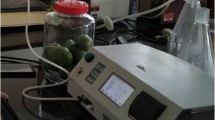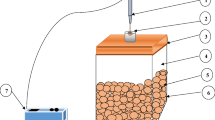Abstract
The present work was undertaken with an objective to evaluate the impact of temperature on respiration rate of fresh black carrot using a non-linear enzyme kinetics approach. Two different models viz. Arrhenius equation (temperature effect) and enzyme kinetics (effect of temperature and headspace concentration) have been compared for predicting the respiration rate of black carrot. The respiratory behavior of black carrot was assessed using closed system technique at 5, 10 and 15 °C (± 1 °C) temperature and constant relative humidity (RH) of 85%. The O2 consumption and CO2 evolution rate values were 39.17, 58.88 and 68.08 ml kg−1 h−1; 22.15, 34.63 and 41.86 ml kg−1 h−1 after the attainment of steady-state condition at 5, 10 and 15 °C, respectively. The inhibition by evolved CO2 was found to be predominantly competitive at all temperatures. The average absolute deviation in O2 consumption and CO2 evolution rate for Arrhenius model was 3.5% and 5.3% while for enzyme kinetics model was 8.8% and 6.3%, respectively. Dependency of respiration rate of black carrot on temperature was well defined by Arrhenius model. The outcomes of the study can be further utilized to design the MAP (modified atmosphere packages) for fresh black carrot storage at 5 °C with 85% RH.




Similar content being viewed by others
Abbreviations
- \({{p}_{{CO}_{2}}}^{f}\) :
-
Final concentration of CO2, %
- \({{p}_{{CO}_{2}}}^{in}\) :
-
Initial concentration of CO2, %
- \({{p}_{{O}_{2}}}^{f}\) :
-
Final concentration of O2, %
- \({{p}_{{O}_{2}}}^{in}\) :
-
Initial concentration of O2, %
- \({Rco}_{2}\) :
-
Respiration rate (rate of CO2 evolution, ml kg−1 h−1)
- \({Ro}_{2}\) :
-
Respiration rate (rate of O2 consumption, ml kg−1 h−1)
- \({V}_{{m}_{{O}_{2}}}\) :
-
Maximum oxygen consumption rate, ml kg−1 h−1
- \({V}_{s}\) :
-
Volume of black carrot sample, ml
- \({V}_{t}\) :
-
Total volume of jar, ml
- \({V}_{v}\) :
-
Void volume of jar, ml
- \({K}_{{m}_{{o}_{2}}}\) :
-
Michaelis–Menten constant for oxygen, %
- \({K}_{{mc}_{{CO}_{2}}}\) :
-
Michaelis–Menten constant for competitive inhibition of O2 consumption by CO2, %
- \({K}_{{mu}_{{CO}_{2}}}\) :
-
Michaelis–Menten constant for uncompetitive inhibition of O2 consumption by CO2, %
- \({t}^{f}\) :
-
Final time, h
- \({t}^{i}\) :
-
Initial time, h
- \({\rho }_{s} \) :
-
Mean density of fresh black carrot, kg l−1
- E a :
-
Activation energy, kJ mol−1
- RH:
-
Relative humidity, %
- \(W\) :
-
Produce weight, kg
- \({W}_{\mathrm{s}}\) :
-
Weight of fresh black carrot inside the impermeable jar, kg
References
Ancos BD, Sgroppo S, Plaza L, Cano MP (2002) Possible nutritional and health- related value promotion in orange juice preserved by high-pressure treatment. J Sci Food Agric 82:790–796
Ayhan Z, Esturk O, Tas E (2008) Effect of modified atmosphere packaging on the quality and shelf life of minimally processed carrots. Turk J Agric For 32:57–64
Barbosa LDN, Carciofi BAM, Dannenhauer CE, Monteiro AR (2011) Influence of temperature on the respiration rate of minimally processed organic carrots (Daucus Carota L. cv. Brasília). Ciênc Tecnol 31:78–85
Beaudry RM, Cameron AC, Shirazi A, Dostal-Lange AL (1992) Modified atmosphere packaging of blueberry fruit: effect of temperature on package O2 and CO2. J Amer Soc Hort Sci 117:436–441
Belay ZA, Caleb OJ, Opara UL (2017) Enzyme kinetics modeling approach to evaluate the impact of high CO2 and super-atmospheric O2 concentrations on the respiration rate of pomegranate arils. Cyta J Food 15:608–616
Benkeblia N (2004) Effect of maleic hydrazine on respiratory parameters of stored onion bulbs (Allium cepa L.). Braz J Plant Physiol 16:47–52
Castellanos DA, Cerisuelo JP, Hernandez-Munoz P, Herrera AO, Gavara R (2016) Modeling the evolution of O2 and CO2 concentrations in MAP of a fresh product: application to tomato. J Food Eng 168:84–95
Chang CC, Yang MH, Wen HM, Chern JC (2002) Estimation of total flavonoid content in propolis by two complementary colorimetric methods. J Food Drug Anal 10:178–182
Copeland RA (2000) Enzymes, 2nd edn. Wiley-VCH, New York
Dhillon HS, Dhillon TS, Devi R (2016) Quality characterization in carrot (Daucus carota L.) Germplasm. Indian J Ecol 43:330–332
Ersan S, Gunes G, Zor AO (2010) Respiration rate of pomegranate arils as affected by O2 and CO2, and design of modified atmosphere packaging. Acta Hort 876:189–196
Fonseca SC, Oliveira FAR, Brecht JK (2002) Modeling respiration rate of fresh fruits and vegetables for modified atmosphere packages: a review. J Food Eng 52:99–119
Galiana-Belaguer L, Ibanez G, Cebolla-Cornejo J, Rosello S (2018) Evaluation of germplasm in Solanum section Lycopersicon for tomato taste improvement. Turk J Agric For 42:309–321
Geysen S, Verlinden BE, Conesa A, Nicolai BM (2005) Modeling respiration of strawberry (cv. Elsanta) as a function of temperature, carbon dioxide, low and super atmospheric oxygen concentration. Frutic 5:12–16
Ghosh T, Dash KK (2018) Respiration rate model and modified atmosphere packaging of bhimkol banana. Eng Agric Environ Food 11:186–195
Guliyev N, Sharifova S, Ojaghi J, Abbasov M, Akparov Z (2018) Genetic diversity among melon (Cucumis melo L.) accessions revealed by morphological traits and ISSR markers. Turk J Agric For 42:393–401
Iqbal T, Rodrigues FAS, Mahajan PV, Kerry JP, Gil L, MC Cunha LM (2008) Effect of minimal processing conditions on respiration rate of carrots. J Food Sci 73:396–402
Iqbal T, Rodrigues FAS, Mahajan PV, Kerry JP (2009) Mathematical modeling of the influence of temperature and gas composition on the respiration rate of shredded carrots. J Food Eng 91:325–332
Ishikawa Y, Sato H, Ishitani T, Hirata T (1992) Evaluation of broccoli respiration rate in modified atmosphere packaging. J Pack Sci Technol 1:143–153
Jerry AB, Jeffrey KB (2002) Postharvest physiology and pathology of vegetables. CRC Press, United States
Kamiloglu S, Camp JV, Capanoglu E (2018) Black carrot polyphenols: effect of processing, storage and digestion- an overview. Phytochem Rev 17:379–395
Kaur A (2018) Physicochemical changes in black carrot during growth and development of roots. J Nutr Food Sci 8:72
Kaur P, Rai DR, Paul S (2011) Nonlinear estimation of respiratory dynamics of fresh-cut spinach (Spinacia oleracea) based on enzyme kinetics. J Food Process Eng 53:1459–1473
Kirandeep KP, Singh B, Kumar N (2018) Effect of temperature and headspace O2 and CO2 concentration on the respiratory behavior of fresh yellow bell- pepper (Mirabelli). Int Chem Stud 6:3214–3220
Kirca A, Ozkan M, Cemeroglu B (2007) Effects of temperature, solid content and pH on the stability of black carrot anthocyanin. Food Chem 101:212–218
Lokke MM, Seefedlt HF, Edwards G, Green O (2011) Novel wireless sensor system for monitoring oxygen, temperature and respiration rate of horticultural crops post harvest. Sensors 11:8456–8468
Mangaraj S, Goswami TK (2011) Measurement and modeling of respiration rate of Guava (cv. Baruipur) for modified atmosphere packaging. Int J Food Prop 14:609–628
Peppelenbos HW, Leven JV (1996) Evaluation of four types of inhibition for modeling influence of carbon dioxide on oxygen consumption of fruits and vegetables. Postharvest Biol Technol 7:27–40
Pereira MJ, Amaro AL, Pintado M, Pocas MF (2017) Modelling the effect of oxygen pressure and temperature on respiration rate of ready-to-eat rocket leaves. A probabilistic study of the Michaelis–Menten model. Postharvest Biol Technol 131:1–9
Rennie TJ, Tavoularis S (2009) Perforation–mediated modified atmosphere packaging: part I. Development of a mathematical model. Postharvest Biol Technol 51:1–9
Rocculia P, Nobile MAD, Romani S, Baiano A, Rosa MD (2006) Use of a simple mathematical model to evaluate dipping and MAP effects on aerobic respiration of minimally processed apples. J Food Eng 76:334–340
Rubatzky VE, Quiros CF, Simon PW (1999) Carrots and related vegetable umbelliferae. CABI, New York
Singh M, Kumar A, Kaur P (2014) Respiratory dynamics of fresh baby corn (Zea mays L.) under modified atmospheres based on enzyme kinetics. J Food Sci Technol 51:1911–1919
Tigist M, Workneh TS, Woldetsadik K (2013) Effects of variety on the quality of tomato stored under ambient conditions. J Food Sci Technol 50:477–486
Tonutare T, Moor U, Szajdak L (2014) Strawberry anthocyanin determination by ph. differential spectroscopic method—how to get true results? Acta Sci Pol-Hortoru 13:35–47
Torrieri E, Perone N, Cavella S, Masi P (2010) Modeling the respiration rate of minimally processed broccoli (Brassica rapa var. sylvestris) for modified atmosphere package design. Int J Food Sci Technol 45:2186–2193
Author information
Authors and Affiliations
Corresponding author
Additional information
Publisher's Note
Springer Nature remains neutral with regard to jurisdictional claims in published maps and institutional affiliations.
Rights and permissions
About this article
Cite this article
Singla, M., Kumar, A., Kaur, P. et al. Respiratory properties of fresh black carrot (Dacus Carota L.) based upon non-linear enzyme kinetics approach. J Food Sci Technol 57, 3903–3912 (2020). https://doi.org/10.1007/s13197-020-04422-5
Revised:
Accepted:
Published:
Issue Date:
DOI: https://doi.org/10.1007/s13197-020-04422-5




